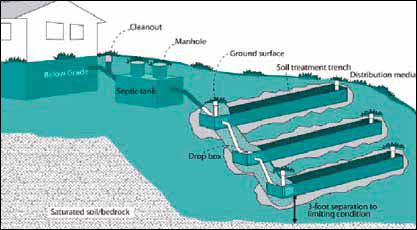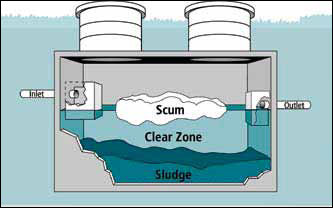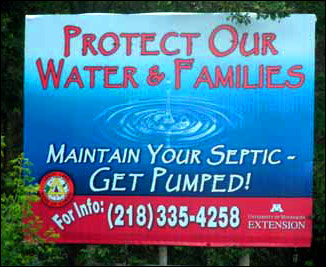 Septic systems
Septic systems
Health Risks of a Failing Septic System
It is unhealthy for humans, pets and wildlife to
drink or come in contact with surface or groundwater contaminated with sewage.
A septic system that is not providing adequate treatment of sewage allows bacteria, viruses and other disease-causing pathogens to enter surface and groundwater. Hepatitis, dysentery, and other diseases can result from drinking or coming in contact with contaminated water. Flies and mosquitoes are attracted to and breed in areas where sewage reaches the surface and can spread disease.
Nitrate levels can be higher in groundwater when a septic system is not providing adequate treatment. Nitrates affect the ability of blood to carry oxygen. High concentrations of nitrates can be of special concern for infants, pregnant women, and adults with compromised immune systems.
Indoor air quality can also be affected by an inadequately vented plumbing system and can release odorous or toxic gasses into a home.
Environmental Risks of a Failing Septic System
A septic system that is not providing adequate treatment allows nutrients (phosphorus and nitrogen) to reach nearby lakes and streams, prompting algae and plant growth. Algal blooms and abundant weeds can change water quality for fish and wildlife habitats. As these plants die, they settle on the bottom, are broken down by bacteria, and use up oxygen that fish and other aquatic species need to survive.
Many household cleaning products, pharmaceuticals, and other chemicals used around the house can be toxic to humans, pets, and wildlife. If disposed of in
the septic system, these products can reach groundwater, surface water or the ground surface.
A properly designed, installed and maintained septic system will provide economical and effective sewage treatment.
How a Septic System Works
There are three main components to a septic system:
- A pipe that carries waste from the house;
- A water tight septic tank; and
- The soil treatment area, which may be a mound or an in-ground drain field.

When wastewater from the laundry, shower and toilet is disposed of, it exits the house through the sewer pipe. The sewage then exits the pipe into the septic tank where it separates into three layers. The solids (or “sludge”) will then sink to the bottom of the tank; a liquid layer will develop just above the sludge, and a scum layer made up of soaps, greases, and toilet paper will form on the top.
The tank’s primary job is to send the liquid layer to the soil treatment area.

Treating sewage is everyone's responsibility!
The final treatment of septic tank effluent occurs in the soil. Uncompacted, unsaturated, undisturbed soil must exist above and below the soil treatment area. Soil treatment destroys disease-causing organisms in the effluent and removes nutrients. If too many solids enter the soil treatment area from the tank the soil treatment area can malfunction.
Preventing System Failure
The effectiveness of a septic system in treating sewage depends on how the homeowner uses the system. Short-term or long-term overuse affects the system. Each septic system is designed based on the number of bedrooms in a home. For example, each person typically uses about 75 gallons of water a day. A system designed for a four-bedroom home is designed to handle up to 600 gallons of water a day. However, the average use of the system should not exceed 420 gallons per day or 70% of the design flow. If more people are staying in the home, each
individual increases the daily flow to the septic system. Increasing the number of people living in a home could quickly impact the efficiency and
effectiveness of a septic system. When the number of people living in a home is more than the system was designed for, the septic tank will need to be pumped more often.
What Can You Do?
In the Bathroom:
- Fix leaks.
- Do not flush any product other than toilet paper.
- Do not use automatic toilet bowl cleaners.
- Install low-flow shower heads.
- Limit the use of antibacterial soap. Bacteria help your system work properly!
- Shaving and bath oils are hard on your system. Do not use excessively.
In the Kitchen:
- Run full loads in your dishwasher.
- If you wash dishes by hand, don’t let the water run.
- Fix leaks.
- Limit the use of antibacterial soap.
- Limit the use of dishwashing detergents.
In the Laundry Room:
- Don’t wash all your laundry in one day; spread the loads throughout the week.
- Install a lint filter on the washing machine.
- Limit the amount of bleach used. Bleach kills bacteria, and bacteria are good for your system.
- Do not use liquid fabric softeners as they inhibit the settling of scum and solids within your tank.
- Water softener recharge water does not require treatment. Discharge this water to a different place. The salt can affect concrete septic tanks and the recharge water may inhibit the settling of scum and solids within your septic tank.
Tank Maintenance
All septic tanks must be pumped every two to three years to remove the floating scum and sludge that accumulates through normal use. A household’s water usage will determine how often tank maintenance should occure. Low-water usage homes might need the tank pumped every two to three years whereas high-water usage
homes should have tanks pumped annually.

Maintaining Your System
Septic Starters, Feeders, Cleaners and Other Additives
There is no substitute for regular maintenance (pumping) of your septic system.
Starters and Feeders are not needed to get bacterial action going in the septic tank. There are enough naturally occurring bacteria present in sewage.
Cleaners – Additives that are effective in removing solids from the tank will probably damage the soil treatment area. Some of these additives can keep small particles suspended in the liquid layer of your septic tank instead of settling at the bottom. These small particles clog pipes which can lead to partial or complete malfunction.
Soil Treatment System Maintenance
Avoid compaction
- Don’t drive or park on the soil treatment area.
- Don’t plow snow cover from the soil treatment area.
- Don’t pile snow on the soil treatment area.
- Avoid the soil treatment area when landscaping your yard. This is not the place
for play equipment or other activities that could compact the soil.
Maintain Vegetative Cover
- Your soil treatment area must have well-established grass cover. This helps prevent erosion of the soil and provides insulation to help prevent freezing.
- Regularly mow the lawn to help keep the grass growing and to maintain adequate density to completely cover the soil surface.
Protect Your System from Freezing
- Don’t mow the grass over the soil treatment area in the late fall.
- Add a layer of mulch eight to twelve inches thick over the pipes, tank and soil
treatment area. This must be removed in the spring to allow vegetative growth! - Do not add automotive antifreeze to the system. Antifreeze is toxic and does not
prevent problems. - Make sure all risers, inspection ports and manholes have tight covers. Replace
any covers that become cracked
![]()
Contact Us
(218) 335-7400 DRM
| Name | Title | Phone |
|---|---|---|
| Brown, Levi | Environmental Director | 335-7417 |
| Harper, Jeff | Water Resources Program Manager | 335-7415 |
septic.umn.edu and refer to the “Septic Systems Owner’s Guide.















 Division of Resource Management
Division of Resource Management